Samsung SNC-B5368P User Manual
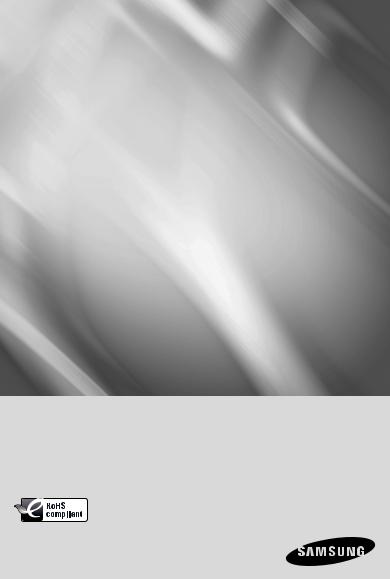
SNC-B5368(P)
Network Camera
User Manual
imagine the possibilities
Thanks you for purchasing this Samsung product. To receive a more complete service, please visit our website
www.samsungsecurity.com
RoHS compliant
Our product complies with “The Restriction Of the use of certain Hazardous Substances in electrical and electronic equipment”, and we do not use the 6 hazardous materialsCadmium (Cd), Lead (Pb), Mercury (Hg), Hexavalent Chromium (Cr+6), Poly Brominated Biphenyls (PBBs), Poly Brominated Diphenyl Ethers (PBDEs)- in our products.
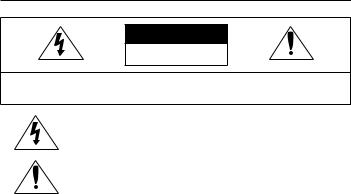
overview
CAUTION
RISK OF ELECTRIC SHOCK.
DO NOT OPEN
CAUTION: TO REDUCE THE RISK OF ELECTRIC SHOCK, DO NOT REMOVE COVER (OR BACK) NO USER SERVICEABLE PARTS INSIDE. REFER SERVICING TO QUALIFIED SERVICE PERSONNEL.
This symbol indicates that dangerous voltage consisting a risk of electric shock is present within this unit.
This symbol indicates that there are important operating and maintenance instructions in the literature accompanying this unit.
WARNING
yTo reduce the risk of fi re or electric shock, do not expose this appliance to rain or moisture.
yTo prevent injury, this apparatus must be securely attached to the fl oor/wall in accordance with the installation instructions.
yIf this power supply is used at 24V ac, a suitable plug adapter should be used.
yThe camera is to be only connected to PoE networks without routing to the outside plant.
WARNING
1.Be sure to use only the standard adapter that is specifi ed in the specifi cation sheet. Using any other adapter could cause fi re, electrical shock, or damage to the product.
2.Incorrectly connecting the power supply or replacing battery may cause explosion, fi re, electric shock, or damage to the product.
3.Do not connect multiple cameras to a single adapter. Exceeding the capacity may cause abnormal heat generation or fi re.
4.Securely plug the power cord into the power receptacle. Insecure connection may cause fi re.
5.When installing the camera, fasten it securely and fi rmly. The fall of camera may cause personal injury.
6.Do not place conductive objects (e.g. screwdrivers, coins, metal parts, etc.) or containers fi lled with water on top of the camera. Doing so may cause personal injury due to fi re, electric shock, or falling objects.
2_ overview

7. Do not install the unit in humid, dusty, or sooty locations. Doing so may cause fi re or electric shock.
8. If any unusual smells or smoke come from the unit, stop using the product. In such case, immediately disconnect the power source and contact the service center. Continued use in such a condition may cause fi re or electric shock.
9. If this product fails to operate normally, contact the nearest service center. Never disassemble or modify this product in any way. (SAMSUNG is not liable for problems caused by unauthorized modifi cations or attempted repair.)
10. When cleaning, do not spray water directly onto parts of the product. Doing so may |
● |
|
OVERVIEW |
||
Otherwise, it may cause moisture condensation inside the Clear Dome due to |
||
cause fi re or electric shock |
|
|
11. Do not expose the product to the direct airfl ow from an air conditioner. |
|
|
temperature difference between internal and external of the dome camera. |
|
|
12. If you install this product in a low-temp area such as inside a cold store, you must seal |
|
|
up the wiring pipe with silicon, so that the external air can not fl ow inside the housing. |
|
|
Otherwise, external high, humid air may fl ow inside the housing, pooling moisture or |
|
|
vapor inside the product due to a difference between internal and external temperature. |
|
CAUTION
1.Do not drop objects on the product or apply strong blows to it. Keep away from a location subject to excessive vibration or magnetic interference.
2.Do not install in a location subject to high temperature (over 50°C), low temperature (below -10°C), or high humidity. Doing so may cause fi re or electric shock.
3.If you want to relocate the already installed product, be sure to turn off the power and then move or reinstall it.
4.Remove the power plug from the outlet when there is a lighting storm. Neglecting to do so may cause fi re or damage to the product.
5.Keep out of direct sunlight and heat radiation sources. It may cause fi re.
6.Install it in a place with good ventilation.
7.Avoid aiming the camera directly towards extremely bright objects such as sun, as this may damage the CCD image sensor.
8.Apparatus shall not be exposed to dripping or splashing and no objects fi lled with liquids, such as vases, shall be placed on the apparatus.
9.The Mains plug is used as a disconnect device and shall stay readily operable at any time.
10.When using the camera outdoors, moisture may occur inside the camera due to temperature difference between indoors and outdoors. For this reason, it is
recommended to install the camera indoors. For outdoor use, use the camera with builtin fan and heater.
English _3

overview
FCC STATEMENT
This device complies with part 15 of the FCC Rules. Operation is subject to the following two conditions :
1)This device may not cause harmful interference, and
2)This device must accept any interference received including interference that may cause undesired operation.
Caution
This equipment has been tested and found to comply with the limits for a Class A digital device, pursuant to part 15 of FCC Rules. These limits are designed to provide reasonable protection against harmful interference when the equipment is operated in a commercial environment.
This equipment generates, uses, and can radiate radio frequency energy and, if not installed and used in accordance with the instruction manual, may cause harmful interference to radio communications. Operation of this equipment in a residential area is likely to cause harmful interference in which case the user will be required to correct the interference at his own expense.
IC Compliance Notice
This Class A digital apparatus meets all requirements of the Canadian
Interference.-Causing Equipment Regulations of ICES-003.
Caution
Danger of explosion if battery is incorrectly replaced.
Replace only with the same or equivalent type.
4_ overview

IMPORTANT SAFETY INSTRUCTIONS
1. |
Read these instructions. |
|
|
2. |
Keep these instructions. |
|
|
3. |
Heed all warnings. |
|
|
4. |
Follow all instructions. |
|
|
5. |
Do not use this apparatus near water. |
● |
|
|
|||
6. |
Clean only with dry cloth. |
|
|
OVERVIEW |
|
||
7. |
Do not block any ventilation openings. Install in accordance with the manufacturer’s |
|
|
|
|
||
|
instructions. |
|
|
8. |
Do not install near any heat sources such as radiators, heat registers, or other apparatus |
|
|
|
(including amplifi ers) that produce heat. |
|
|
9. |
Do not defeat the safety purpose of the polarized or grounding-type plug. |
|
|
|
A polarized plug has two blades with one wider than the other. A grounding type plug |
|
|
|
has two blades and a third grounding prong. The wide blade or the third prong is |
|
|
|
provided for your safety. If the provided plug does not fi t into your outlet, consult an |
|
|
|
electrician for replacement of the obsolete outlet. |
|
|
10. Protect the power cord from being walked on or pinched particularly at plugs, |
|
|
|
|
convenience receptacles, and the point where they exit from the apparatus. |
|
|
|
|
|
|
11. Only use attachments/accessories specifi ed by the manufacturer. |
|
|
|
12. Use only with the cart, stand, tripod, bracket, or table specifi ed by |
|
|
|
|
the manufacturer, or sold with the apparatus. When a cart is used, |
|
|
|
use caution when moving the cart/apparatus combination to avoid |
|
|
|
injury from tip-over. |
|
|
13. Unplug this apparatus during lightning storms or when unused for |
|
|
|
|
long periods of time. |
|
|
14. Refer all servicing to qualifi ed service personnel. Servicing is required when the |
|
|
|
|
apparatus has been damaged in any way, such as powersupply cord or plug is |
|
|
|
damaged, liquid has been spilled or objects have fallen into the apparatus, the apparatus |
|
|
|
has been exposed to rain or moisture, does not operate normally, or has been dropped. |
|
|
|
Apparatus shall not be exposed to dripping or splashing and no objects |
|
|
|
filled with liquids, such as vases, shall be placed on the apparatus |
|
|
English _5

overview
CONTENTS
OVERVIEW
2
INSTALLATION & CONNECTION
14
CAMERA SETUP
20
NETWORK CONNECTION AND SETUP
29
5 Important Safety Instructions
8 Product Features
8Recommended PC Specifications
9What’s Included
10At a Glance
14Removing the Covers
15Connecting with other Device
17 Installation
20How to use the Keyboard Controller
21Main Menu
21Profile
22Camera Setup
26Privacy Zone
27Others
28System Info
28Language
29Connecting the Camera to an IP Router with the xDSL/Cable Modem
30Connecting the Camera to an IP Router with Local area Networking
31Connecting the Camera Directly to a DHCP-Based xDSL/Cable Modem
32Connecting the Camera Directly to Local area Networking
33IP Address Setup
34Static IP Setup
37Dynamic IP Setup
38Port Range Forward (Port Mapping) Setup
38Connecting to the Camera from a Shared Local PC
39Connecting to the Camera from a Remote PC via the Internet
6_ overview

WEB VIEWER |
40 |
Connecting to the Camera |
40 |
41 |
Login |
42 |
Installing ActiveX |
|
43 |
Using the Live Screen |
|
44 |
Backup |
|
SETUP SCREEN |
46 |
Accessing the Setup Screen |
46 |
47 |
Default Setup |
51 |
System Setup |
|
54 |
Overlay Setup |
|
55 |
Event Setup |
|
|
60 |
Network Setup |
APPENDIX |
62 |
Profile |
62 |
63 |
Terminology |
64 |
Specifications |
|
68 |
Frame Rate (NTSC) |
|
74 |
Frame Rate (PAL) |
|
|
80 |
Troubleshooting |
OVERVIEW ●
English _7

overview
PRODUCT FEATURES
ySupport various communication protocols
Supports TCP/IP, UDP, RTP/RTSP, SMTP for email, and FTP protocols as well as various internet protocols such as ARP, HTTP, HTTPS and DHCP.
yWeb Browser-based Monitoring
Using the Internet web browser to display the image in a local network environment.
yAutomatic Local IP Setup
Even a network novice can install it with minimum operations.
yAlarm
If the camera equipped with an alarm sensor senses any motion, it will send a notifi cation to a user FTP/email account (SMTP) or send the corresponding signal to the Alarm Out terminal.
yMotion Detection
If the camera with a specifi ed motion area detects a motion in that area, it will send a
notifi cation to a user FTP/email account (SMTP) or send the corresponding signal to the Alarm Out terminal.
RECOMMENDED PC SPECIFICATIONS
yCPU : Pentium4 / 2.4GHz or higher
yOperating System : Windows XP(Service Pack2, Service Pack3) / Windows Vista
yResolution : 1024X768 pixels or higher
yRAM : 512MB or higher
yWeb Browser : Internet Explorer 6.0 or higher
yVideo Card : Radeon, Nvidia
yVideo Memory: 128MB
yDirectX 8.1 or higher
Compatible IP Routers
yLinksys
yD-Link
yNetgear
Compatible PoE Switches
yLinksys SRW224G4P
yD-Link DES-1316
ySMC SMCPWR-INJ3
8_ overview
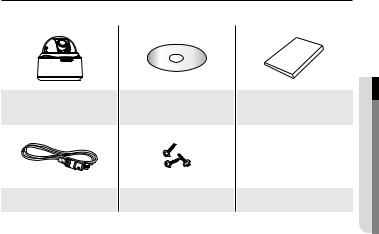
WHAT’S INCLUDED
Please check if your camera and accessories are all included in the product package.
Camera |
User Manual/ |
User Manual |
|
IP INSTALLER CD |
|||
|
|
Test Monitor Cable |
Screw |
MThe Test Monitor Cable is connected to a portable displayer and used for testing the camera. If you intend to use it for an actual monitoring camera, use the BNC cable instead.
OVERVIEW ●
English _9
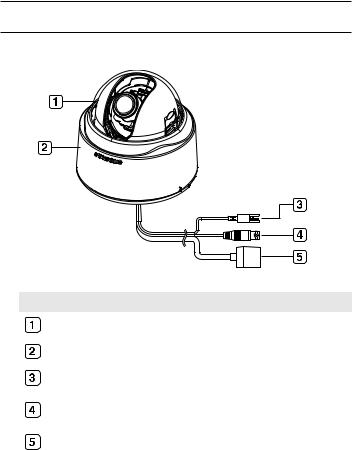
overview
AT A GLANCE
Appearance
Item |
Description |
|
|
|
|
Dome Cover |
Case cover used to protect the lens and the main unit. |
|
|
|
|
Main Unit |
Consists of: lens, switch board, PCB and screws. |
|
|
|
|
Power Port |
Used to plug in the power cable. |
|
|
|
|
Video Output Port |
Used to connect the Video In connector of the monitor, from which the video |
|
signal of the camera outputs. |
||
|
||
|
|
|
Network Port |
Used to connect the PoE or LAN cable. |
|
|
|
MWipe out a dirty surface of the lens softly with a lens tissue or cloth to which you have applied ethanol.
10_ overview
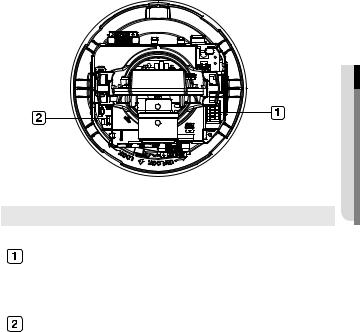
Inside
OVERVIEW ●
Item |
Description |
|
|
|
|
|
Consists of two different ports: |
|
Alarm I/O Port |
- ALARM IN : Used to receive the alarm input signal. |
|
- ALARM OUT : Used to output the alarm output signal. |
||
|
||
|
- GND : Used for earth-grounding. |
|
|
|
|
|
Restores all camera settings to the factory default. Press and hold it for |
|
|
about 3 seconds to turn off the system indicator and restart the system. |
|
Reset Button |
J After resetting the camera, you must run the IP Installer program to |
|
|
change the basic network settings such as IP address, Subnet mask, |
|
|
Gateway, etc., before you can connect to the network. |
|
|
|
English _11
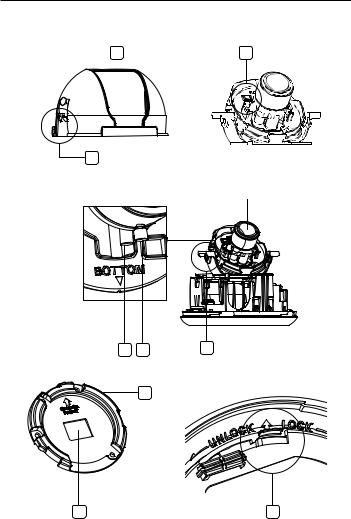
overview
Components
1 |
3 |
2
Lens
4 |
5 |
6 |
7
8 |
9 |
12_ overview
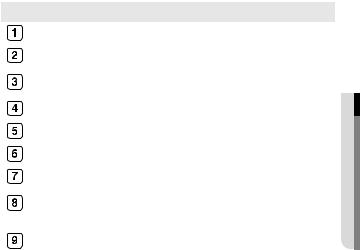
Item |
Description |
|
|
|
|
Inner Cover |
Cover used to protect the main unit. |
|
|
|
|
Wing-Side Hook |
Tap on either end to remove the inner cover. |
|
|
|
|
Monitor Out |
The Test Monitor Cable is connected to a portable displayer and used for |
|
testing the camera. |
||
|
||
|
|
|
Zoom Lever |
Used to adjust or fix the zoom factor of the lens. |
|
|
|
|
Focus Lever |
Turn it to the left or right to adjust the focus; turn it clockwise to fix the focus. |
|
|
|
|
Tilt Screw |
Used to adjust or fix the tilt of the lens. |
|
|
|
|
Bracket |
Used to install the camera on the wall or ceiling with the screws. |
|
|
|
|
Upper Lid |
Remove this for wiring purposes if you intend to install the camera on the |
|
ceiling. |
||
|
||
|
|
|
|
If you want to remove the bracket from the main unit or remove the camera |
|
Release Lock |
from the bracket, push this out and turn the main unit in the <UNLOCK> |
|
|
direction. |
|
|
|
OVERVIEW ●
English _13
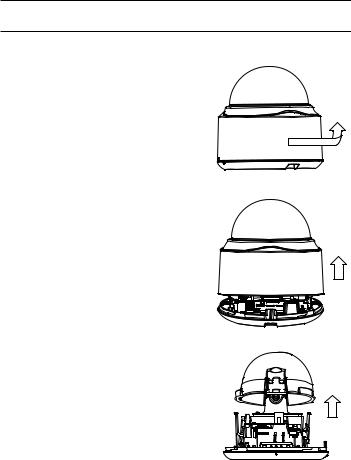
installation & connection
REMOVING THE COVERS
If you want to connect the Alarm I/O connectors, you must remove the dome cover and lens cover beforehand.
1. Turn the dome cover counter-clockwise.
2. Remove the dome cover by lifting it up.
3. Tap on either end of the lens cover to remove it.
14_ installation & connection
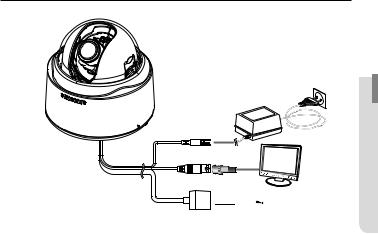
CONNECTING WITH OTHER DEVICE
Power
Monitor


 Network
Network
Power Supply
Connect the power adaptor to the power input port.
J Be careful not to reverse the polarity when you connect the power cable.
You can also use a router featuring PoE (Power over Ethernet) to supply power to the camera.
Connecting to the monitor
Connect the [V_OUT] port of the camera to the video input port of the monitor.
Network Connection
Connect the Network cable to the local network or to the Internet.
 CONNECTION & INSTALLATION ●
CONNECTION & INSTALLATION ●
English _15
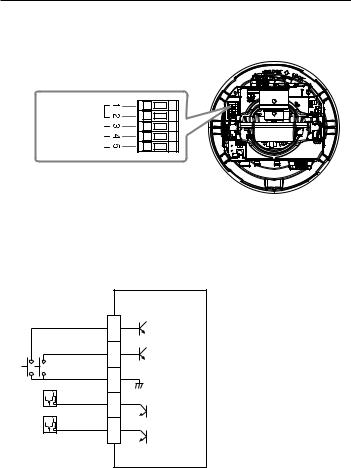
installation & connection
Connecting to the I/O port box
Connect the Alarm I/O cable to the corresponding port of the inner port box.
ALARM IN
GND
ALARM OUT 
yALARM IN 1, 2 : Used to connect the alarm input signal.
yGND : Used for earth-grounding.
yALARM OUT 1, 2 : Used to connect the alarm output signal.
Alarm I/O Wiring Diagram
ALARM IN 1
1
ALARM IN 2
2
GND
3
External Relay
ALARM OUT 1
4
External Relay
ALARM OUT 2
5
16_ installation & connection

INSTALLATION
Precautions before installation
Ensure you read out the following instructions before installing the camera:
ySelect an installation site (ceiling or wall) that can endure at least 5 times of the camera weight.
yStuck-in or peeled-off cables can cause damage to the product or a fire.
yFor safety purposes, keep anyone else away from the installation site. And put aside personal belongings from the site, just in case.
Installing the camera
1.Hold down the bottom lock lever while removing the cover with the other hand. Removing the cover reveals the main unit and inner cover.
2.To fi x the camera position, hold down either hook of the inner cover and lift it up.
3.Push the release lock out while turning the main unit in the <UNLOCK> direction to remove the bracket.
If this doesn't work, use the hole on the bottom of the bracket to turn the bracket in the <LOCK> direction.
 CONNECTION & INSTALLATION ●
CONNECTION & INSTALLATION ●
English _17
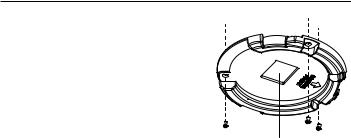
installation & connection
4.Use the provided screws (x3) to fi x the bracket to a desired position (ceiling or wall).
Ensure that the <CAMERA FRONT> label on the bracket faces the direction for camera monitoring.
Upper Lid
5.Arrange the cables through the bracket to the ceiling or wall.
Press hard the upper lid down to remove it before you can arrange the cables through to the ceiling.
If you do not intend to install the camera on the ceiling, use the opposite empty area to the <CAMERA FRONT> label side for the wiring.
6.Mount the main unit onto the bracket.
Align the marking hole of the main unit with the <CAMERA FRONT> label of the bracket, and turn the unit in the <LOCK> direction.
7.Adjust the lens in a desired direction.
For adjusting the lens direction, refer to "Adjusting the monitoring direction for the camera".
8.Secure the inner cover to the main unit.
Fit the two holes of the wing-side locks on the inner cover into the corresponding hole of the main unit, and press it down until you hear a click.
9.Fix the cover to the main unit.
Fit the protruding part inside the cover into the corresponding hole of the main unit, and turn the cover to fi x it.
18_ installation & connection
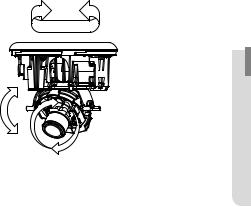
Adjusting the monitoring direction for the camera
Panning
Tilting
Lens rotation
You can adjust the camera direction only when the camera is fixed on the ceiling.
Then, turning the camera to the left or right is referred to as "Panning", while tilting the angle is "Tilting". For panning, the panning limit is 220˚ for the clockwise, and 120˚ for the counterclockwise, a total of 340˚ enabled; further rotation is stopped by the stopper.
 CONNECTION & INSTALLATION ●
CONNECTION & INSTALLATION ●
English _19
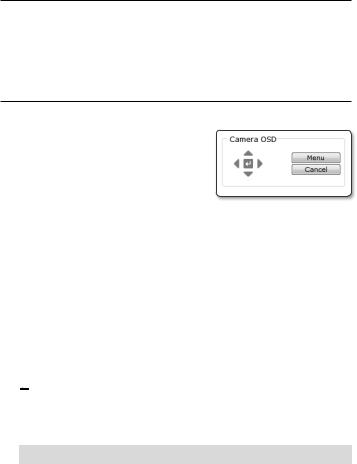
camera setup
You can configure the camera settings using the Web Viewer.
M For accessing the Web Viewer, refer to "Network Connection and Setup". (page 29)
HOW TO USE THE KEYBOARD CONTROLLER
Follow the steps below if you run the Web Viewer for setting the menus.
1.Launch the Web Viewer.
2.From the [Camera OSD] menu in the left pane, click [Menu].
The <MAIN MENU> screen appears.
3.Click the Up/Down (▲▼) buttons to move to a desired item.
4.Click the four direction (▲▼◄ ►) buttons to navigate through the menu items.
5.To change the value of a selected item, click the Left/Right (◄ ►) buttons.
6.Click [  ].
].
Your changes will be applied.
 : Exits the menu setup screen.
: Exits the menu setup screen.
Before exiting the setup screen, select [SAVE] to save your settings, or [QUIT] to cancel them.
 : Saves your settings and returns to the previous screen.
: Saves your settings and returns to the previous screen.
 : Returns to the main menu.
: Returns to the main menu.
 : Use this icon if you want to save your settings after you specified the mask area and privacy area, etc.
: Use this icon if you want to save your settings after you specified the mask area and privacy area, etc.
Once you saved your settings, the changes remain intact even if you select [QUIT] on exit.
 : Use this icon if you want to delete a mask, or privacy area, etc.
: Use this icon if you want to delete a mask, or privacy area, etc.
Once you deleted your settings, the deletions remain valid even if you select [QUIT] on exit.
 : This arrow appears next to a menu that contains sub items.
: This arrow appears next to a menu that contains sub items.
For the items with the "*" mark on the right, You can get help from "Terminology". (page 63)
20_ camera setup
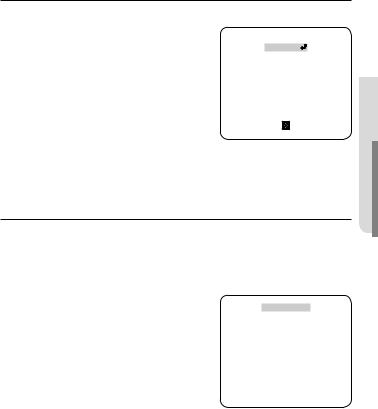
MAIN MENU
You can configure the camera settings to your preference.
yPROFILE
You can select a mode that is appropriate to the camera installation environment.
yCAMERA SET
Confi gure the camera functions and settings.
yPRIVACY ZONE
You can confi gure the privacy settings.
yOTHER SET
**MAIN MENU **
PROFILE
CAMERA SET  PRIVACY ZONE
PRIVACY ZONE  OTHER SET
OTHER SET  SYSTEM INFO
SYSTEM INFO  LANGUAGE
LANGUAGE 
You can confi gure more settings including
FACTORY DEFAULTS.
ySYSTEM INFO
Shows the camera version and type.
yLANGUAGE
Select a preferred one from the supported languages.
PROFILE
You can select one from the pre-determined modes as appropriate to your specific camera installation environment.
Your selection on each item in PROFILE will affect all other settings of the camera. For the setting, refer to "PROFILE". (page 62)
For selecting and saving each menu item, refer to "How to use the keyboard controller". (page 20)
ySTANDARD
Automatically optimizes the camera settings to the normal environment.
yITS
This setting enables you to analyze the traffi c situation and take the traffi c information at a glance.
◄ PROFILE ►
*STANDARD
ITS
BACKLIGHT DAY/NIGHT GAMING CUSTOM
yBACKLIGHT
This setting enables you to view a sharp background
and object even in a severe backlight scene. 

yDAY/NIGHT
Automatically optimizes the camera settings to the day and night scene.
yGAMING
This automatically confi gures the settings so that you can work in a stable illumination condition as indoors.
yCUSTOM
Your change to any of the PROFILE settings will switch the display to CUSTOM.
 SETUP CAMERA ●
SETUP CAMERA ●
English _21

camera setup
CAMERA SETUP
You can configure the general settings of the camera module.
Use the four direction (▲▼◄ ►) buttons to select a desired item.
CAMERA ID
Provide the ID and position for a camera that displays on the screen.
For selecting and saving each menu item, refer to "How to use the keyboard controller". (page 20)
1.Select <CAMERA SET> - <CAMERA ID>.
2.Use the four direction (▲▼◄ ►) buttons to select a desired character.
In the lower input box of the screen, the selected character will be entered.
You can enter up to 54 characters including alphabets, numbers and special characters.


 CAMERA ID
CAMERA ID 
ABCDEFGHIJKLMNOPQRSTUVWXYZO 123456789 : ?_+*()/
SP►► ◄◄SP |
LOCATION |
-- - - - - - - - - - - - - - - - - - - - - - - -
-- - - - - - - - - - - - - - - - - - - - - - - -
3. When done, continue to select <LOCATION> to specify the display position of the camera ID.
IRIS
You can set the iris to control the intensity of radiation incoming to the camera.
For selecting and saving each menu item, refer to "How to use the keyboard controller". (page 20)
1. |
Select <CAMERA SET> - <IRIS>. |
|
|
|
|
|
2. |
Use the left/right (◄ ►) buttons to select <ALC>. |
|
|
ALC |
|
|
|
|
|
||||
|
|
|
||||
|
y LEVEL : Select an overall brightness level. |
LEVEL |
|
[ 00] ---- I ---- |
||
|
BACKLIGHT |
|
|
OFF |
||
|
|
|
|
|||
yBACKLIGHT : Select either <BLC> or <WDR>.
-WDR : Specify the synthesis level in the WEIGHT, and shutter speed in the
WDR LEVEL, or select <OUTDOOR> or <INDOOR> in the WHITE BAL.
-BLC : Set the <BLC> area by specifying the <SIZE> and <POSITION>.
M If the iris is set to <ALC>, fixing the iris is your priority when you adjust AE and the shutter speed.
22_ camera setup
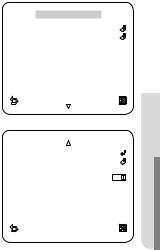
MOTION
You can specify a level of AGC for controlling the camera motion.
Select F.FAST if you want to monitor a very fast moving object in a low contrast scene, and S.SLOW if monitoring a very slow moving, inanimate object in the same condition.
As long as DAY/NIGHT is set to AUTO, the <MOTION> menu is not available.
◄ CAMERA SET ►
CAMERA ID |
ON |
IRIS |
ALC |
MOTION |
(F.FAST)--- |
DNR |
MID |
SHUTTER |
OFF |
SENS-UP |
AUTO X4 |
FLICKERLESS |
OFF |
XDR |
MID |
DIS |
OFF |
DNR
Reduces the noise on the screen.
This is useful, especially for a noisy screen. Set it to <USER>, you can specify the level.
SHUTTER
The SHUTTER menu is used to set the fixed fast electronic shutter or auto fast electronic shutter.
DAY/NIGHT |
AUTO |
WHITE BAL |
|
DIGITAL ZOOM |
OFF |
DETAIL |
[2] |
AGC COLOR SUP |
MID |
REVERSE |
OFF |
POSI/NEGA |
+ |
PIP |
OFF |
SENS-UP
If the brightness of the video signal is too low, the Slow Shutter function will be activated. Slow Shutter can collect the individual max frame rate to adjust the setting.
FLICKERLESS
If set to <ON>, the shutter speed will be fixed to 1/100 second. This will prevent possible screen distortion due to a mismatch between the vertical sync frequency and the blinking frequency of the lighting.
If SHUTTER is set to AUTO, FIX, EXT mode / SENSE UP to FIX / AGC to FIX, the <DIS> menu will be disabled.
XDR
This will correct a brightness difference between different scenes for the optimal visibility. The higher the value is, the higher the correction level is.
DIS
Automatically compensates for the flicker on the screen.
If set to <ON>, the image will be enlarged with digital zoom as much area as compensated.
 SETUP CAMERA ●
SETUP CAMERA ●
English _23
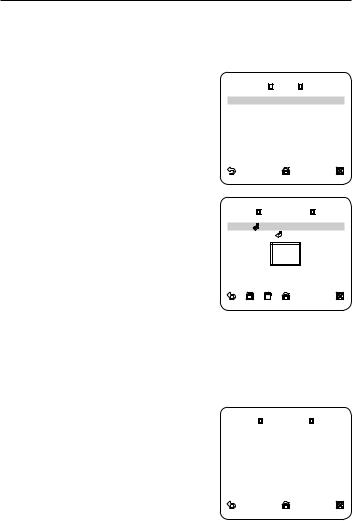
camera setup
DAY/NIGHT
You can specify a recording mode according to the scene.
For selecting and saving each menu item, refer to "How to use the keyboard controller". (page 20)
1.Select <CAMERA SET> - <DAY/NIGHT>.
2.Select a screen transition mode according to the illumination, and set options as appropriate.
y DAY : Fixed to DAY mode, regardless of the scene.
y NIGHT : Fixed to NIGHT mode, regardless of the scene.
If BURST is set to <ON>, the burst signal will output.
y AUTO : According to the luminance, this will switch DAY to NIGHT mode, or vice versa.
y DAY NIGHT / NIGHT DAY : If set to <AUTO>, you can specify the brightness level triggering the mode switch between DAY and NIGHT as well as the interval.
y MASK AREA : If there exists a bright spot light source in a night scene, you can specify the size and position as needed.
Any excessively bright area in a night scene will be masked.
AUTO |
|
BURST |
OFF |
DAY NIGHT |
|
BRIGHTNESS |
MID |
DWELL TIME |
2S |
NIGHT DAY |
|
BRIGHTNESS |
MID |
DWELL TIME |
5S |
MASK AREA |
1 2 |
MASK AREA |
|
<SIZE> |
|
<LOCATION> |
|
WHITE BAL
If you need to adjust the screen brightness, use the WHITE BALANCE function.
For selecting and saving each menu item, refer to "How to use the keyboard controller". (page 20)
1.Select <CAMERA SET> - <WHITE BAL>.
2.Select a mode where you set the balance.
y DAY : You can set the RED, and BLUE value in DAY mode.
y NIGHT : You can adjust the <WHITE BAL> according to the ambient luminance.
|
|
WHITE BAL |
|
|
|
|
|
|
|
||
|
|
|
|
|
|
DAY/NIGHT |
|
|
DAY |
||
MODE |
[ |
00] |
|
ATW2 |
|
RED |
|
I ---- |
|||
BLUE |
[ |
00] ---- |
|
I ---- |
|
24_ camera setup
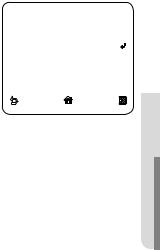
3.According to the specifi ed recording mode, select a WHITE BAL mode with necessary options.
y BRIGHTNESS : Specify a brightness level triggering the switch from DAY to NIGHT mode.
y MODE : According to the selected mode, you can adjust the RED and BLUE color level.
-RED : Adjust the strength of the red color.
-BLUE : Adjust the strength of the blue color.


 WHITE BAL
WHITE BAL 
DAY/NIGHT |
|
|
|
NIGHT |
|
|
|
BRIGHTNESS |
|
|
|
MID |
|
|
MODE |
|
|
|
AWC |
|
|
RED |
[ 00] ---- I ---- |
|
|||
|
BLUE |
[ 00] ---- I ---- |
|
|||
|
R-GAIN |
[0040] |
|
|
|
|
|
|
|
|
|
||
|
B-GAIN |
[0133] |
|
|
|
|
-R-GAIN/B-GAIN : Specify the current color temperature manually.
You can set the R-GAIN, and B-GAIN value only in AWC mode.
DIGITAL ZOOM
You can set the digital zoom factor and position.
When the zoom factor and position are defined, the digital zoom function will operate.
If you set the digital zoom to a larger factor than the actual enlargement for compensation, the DIS function will be disabled.
DETAIL
You can adjust the vertical and horizontal sharpness, respectively.
AGC COLOR SUP
This will adjust the color scheme according to the AGC value.
REVERSE
This will reverse the signal left to right, top to bottom, or a combination of the preceding.
POSI/NEGA
This will display the video brightness signal either normally or reversely.
PIP
You can view a main image with a sub image on the same screen.
 SETUP CAMERA ●
SETUP CAMERA ●
English _25

camera setup
PRIVACY ZONE
You can set up to 12 privacy zones that will be hided for privacy of the subject when recording.
For selecting and saving each menu item, refer to "How to use the keyboard controller". (page 20)
ZONE SETUP
1. |
Select <MAIN MENU> - <PRIVACY ZONE>. |
|
|
|
|
|
|
|
2. |
Use the four direction (▲▼◄ ►) buttons to |
|
◄ PRIVACY ZONE ► |
|
||||
1 |
2 |
3 |
4 |
5 |
6 |
|||
|
select a desired number. |
|||||||
|
The Zone setup screen appears. |
7 |
8 |
9 |
10 |
11 |
12 |
|
|
PRIVACY SET |
|
|
ON |
||||
|
|
|
|
|||||
|
|
STYLE |
|
|
MOSAIC1 |
|||
3. |
Select the <PIXEL LEVEL>. |
|
|
|
|
|
|
|
|
Specify the pixel unit level for the POSITION set- |
|
|
PRIVACY ZONE SET 1 |
|
|
||
|
|
|
|
|||||
|
|
|
|
|||||
|
ting. |
|
|
|
|
|
|
|
|
PIXEL LEVEL |
[4] |
|
|
|
|||
4. |
Select <POINT>. |
<POINT> |
|
|
|
|
||
<POSITION> |
|
|
|
|
||||
You will see dots on the screen.
5.Use the four direction (▲▼◄ ►) buttons to specify the position for each of the four dots.
6. Select <POSITION> and use the four direction (▲▼◄ ►) buttons to specify the position for each of the four dots.
7.Save the changes and move to the previous screen and select the <STYLE>. Select <COLOR> and pick a desired color.
M Setting one or more privacy zone and enabling privacy function will disable the PIP function.
26_ camera setup
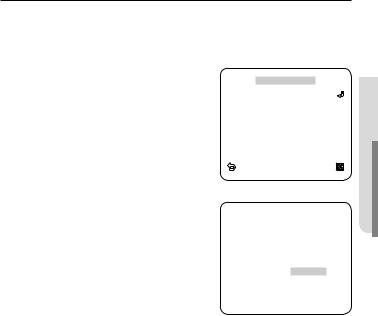
OTHERS
You can reset the camera, or select the OSD font color to your preference.
For selecting and saving each menu item, refer to "How to use the keyboard controller". (page 20)
FACTORY DEFAULT
1.Select <MAIN MENU> - <OTHER SET> - <FACTORY DEFAULTS>.
The FACTORY DEFAULTS setup screen appears.
◄ OTHER SET ► |
|
FACTORY DEFAULTS |
|
OSD COLOR |
BW |
 SETUP CAMERA ●
SETUP CAMERA ●
2.Select <OK>.
All the settings will be restored to the factory default.
However, the language setting will not be restored.



 FACTORY DEFAULTS
FACTORY DEFAULTS 



OK CANCEL
OSD COLOR
You can set the font color of the user interface.
English _27

camera setup
SYSTEM INFO
You can check the system information.
For selecting and saving each menu item, refer to "How to use the keyboard controller". (page 20)
1. |
Select <MAIN MENU> - <SYSTEM INFO>. |
|
|
|
2. |
The current system information is displayed. |
◄ SYSTEM INFO ► |
|
|
|
3_IPV_N |
|||
|
TYPE |
|||
|
CAMERA VER. |
v1.00_090724 |
||
MThe camera type may different, depend on the video signal.
LANGUAGE
You can select a language to your preference.
For selecting and saving each menu item, refer to "How to use the keyboard controller". (page 20)
1.Select <MAIN MENU> - <LANGUAGE>.
2.Select your preferred language using the up/down (▲▼) buttons.
M Supported language may different.
◄ LANGUAGE ►
*ENGLISH
FRANÇAIS DEUTSCH ESPAÑOL ITALIANO
28_ camera setup
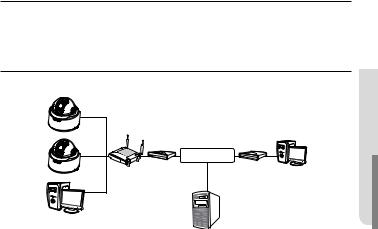
network connection and setup
You can set up the network settings according to your network configurations.
CONNECTING THE CAMERA TO AN IP ROUTER WITH THE XDSL/CABLE MODEM
This is for a small network environment such as homes, SOHO and ordinary shops.
SNC-B5368 |
|
|
|
|
|
|
|
|
|
INTERNET |
|
|
|
|
kzsG |
G |
kzsG |
G |
|
|
|
xDSL or |
|
xDSL or |
|
|
|
pw |
j G |
|
j G |
|
G |
Gwj |
IP Router |
Cable Modem |
Cable Modem |
External Remote PC |
|||
SNC-B5368 |
|
|
|
|
|
|
wj |
|
|
|
|
|
|
Local PC |
|
|
|
|
|
|
DDNSkkuzG Server
Ok Gj SGrvylhP
(Data Center, KOREA)
Configuring the network settings of the local PC connected to an IP router
Configuring the network settings of the local PC connected to an IP router, follow the instructions below.
ySelect : <Network Neighborhood> <Properties> <Local Area Connection>
<Properties> <General> <Internet Protocol (TCP/IP)> <Properties>
<Obtain an IP address automatically> or <Use the following IP address>.
yFollow the instructions below if you select <Use the following IP address>:
ex1) If the address (LAN IP) of the IP router is 192.168.1.1 IP address: 192.168.1.100
Subnet Mask: 255.255.255.0 Default Gateway: 192.168.1.1
ex2) If the address (LAN IP) of the IP router is 192.168.0.1 IP address: 192.168.0.100
Subnet Mask: 255.255.255.0 Default Gateway: 192.168.0.1
ex3) If the address (LAN IP) of the IP router is 192.168.xxx.1 IP address: 192.168.xxx.100
Subnet Mask: 255.255.255.0 Default Gateway: 192.168.xxx.1
M For the address of the IP router, refer to the product’s documentation.
 SETUP AND CONNECTION NETWORK ●
SETUP AND CONNECTION NETWORK ●
English _29
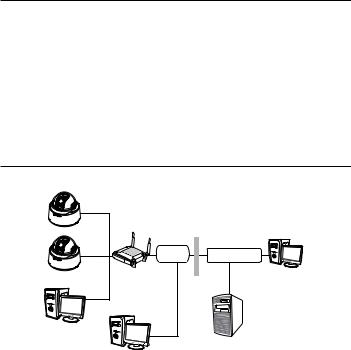
network connection and setup
Checking if the IP router is connected to the xDSL/Cable modem properly
Select <Status> from the Settings menu of the IP Router
yIf it is properly connected, <IP Address>, <Subnet Mask> and <Gateway> provided by your ISP are displayed. Please remember these values because they are required so that an external remote computer of the IP router connects to the camera. However, note that certain ISPs change the settings of <IP Address>, <Subnet Mask> and <Gateway> on a regular basis
yIf the IP router is not properly connected, press the [Connect] button to try to reconnect or check if the settings of the IP router are correct.
CONNECTING THE CAMERA TO AN IP ROUTER WITH LOCAL AREA NETWORKING
This is for a large network environment such as corporate office, building, public office and factory.
SNC-B5368 |
|
|
|
|
|
Switch |
INTERNET |
|
|
HUB |
|
|
|
|
|
|
pwG |
|
External RemoteG Gwj PC |
SNC-B5368 |
IP Router |
|
|
|
|
Firewall |
|
|
|
|
|
Gwj |
|
|
|
Local PC |
|
|
|
|
|
|
DDNSkkuzGServer |
|
|
|
Ok Gj SGrvylhP |
|
Local PC |
|
(Data Center, KOREA) |
|
|
|
Configuring the network settings of the local PC connected to an IP router
Configuring the network settings of the local PC connected to an IP router, follow the instructions below.
ySelect : <Network Neighborhood> <Properties> <Local Area Connection>
<Properties> <General> <Internet Protocol (TCP/IP)> <Properties>
<Obtain an IP address automatically> or <Use the following IP address>.
yFollow the instructions below if you select <Use the following IP address>:
ex1) If the address (LAN IP) of the IP router is 192.168.1.1 IP address: 192.168.1.100
Subnet Mask: 255.255.255.0 Default Gateway: 192.168.1.1
30_ network connection and setup
